2.2E: Exercises
- Page ID
- 120128
\( \newcommand{\vecs}[1]{\overset { \scriptstyle \rightharpoonup} {\mathbf{#1}} } \)
\( \newcommand{\vecd}[1]{\overset{-\!-\!\rightharpoonup}{\vphantom{a}\smash {#1}}} \)
\( \newcommand{\id}{\mathrm{id}}\) \( \newcommand{\Span}{\mathrm{span}}\)
( \newcommand{\kernel}{\mathrm{null}\,}\) \( \newcommand{\range}{\mathrm{range}\,}\)
\( \newcommand{\RealPart}{\mathrm{Re}}\) \( \newcommand{\ImaginaryPart}{\mathrm{Im}}\)
\( \newcommand{\Argument}{\mathrm{Arg}}\) \( \newcommand{\norm}[1]{\| #1 \|}\)
\( \newcommand{\inner}[2]{\langle #1, #2 \rangle}\)
\( \newcommand{\Span}{\mathrm{span}}\)
\( \newcommand{\id}{\mathrm{id}}\)
\( \newcommand{\Span}{\mathrm{span}}\)
\( \newcommand{\kernel}{\mathrm{null}\,}\)
\( \newcommand{\range}{\mathrm{range}\,}\)
\( \newcommand{\RealPart}{\mathrm{Re}}\)
\( \newcommand{\ImaginaryPart}{\mathrm{Im}}\)
\( \newcommand{\Argument}{\mathrm{Arg}}\)
\( \newcommand{\norm}[1]{\| #1 \|}\)
\( \newcommand{\inner}[2]{\langle #1, #2 \rangle}\)
\( \newcommand{\Span}{\mathrm{span}}\) \( \newcommand{\AA}{\unicode[.8,0]{x212B}}\)
\( \newcommand{\vectorA}[1]{\vec{#1}} % arrow\)
\( \newcommand{\vectorAt}[1]{\vec{\text{#1}}} % arrow\)
\( \newcommand{\vectorB}[1]{\overset { \scriptstyle \rightharpoonup} {\mathbf{#1}} } \)
\( \newcommand{\vectorC}[1]{\textbf{#1}} \)
\( \newcommand{\vectorD}[1]{\overrightarrow{#1}} \)
\( \newcommand{\vectorDt}[1]{\overrightarrow{\text{#1}}} \)
\( \newcommand{\vectE}[1]{\overset{-\!-\!\rightharpoonup}{\vphantom{a}\smash{\mathbf {#1}}}} \)
\( \newcommand{\vecs}[1]{\overset { \scriptstyle \rightharpoonup} {\mathbf{#1}} } \)
\( \newcommand{\vecd}[1]{\overset{-\!-\!\rightharpoonup}{\vphantom{a}\smash {#1}}} \)
Exercises
In Exercises 1 - 15, solve the equation.
- \(|x| = 6\)
- \(|3x-1| = 10\)
- \(|4-x| = 7\)
- \(4 - |x| = 3\)
- \(2|5x+1| - 3 = 0\)
- \(|7x-1| + 2 = 0\)
- \(\dfrac{5 - |x|}{2} = 1\)
- \(\frac{2}{3} |5-2x| - \frac{1}{2} = 5\)
- \(|x| = x + 3\)
- \(|2x-1| = x+1\)
- \(4 - |x| = 2x+1\)
- \(|x-4| = x-5\)
- \(|x| = x^2\)
- \(|x| = 12 - x^2\)
- \(|x^2 - 1| = 3\)
Prove that if \(\ |f(x)|=|g(x)|\) then either \(\ f(x)=g(x)\) or \(\ f(x)=-g(x)\). Use that result to solve the equations in Exercises 16 - 21.
- \(\ |3 x-2|=|2 x+7|\)
- \(\ |3 x+1|=|4 x|\)
- \(\ |1-2 x|=|x+1|\)
- \(\ |4-x|-|x+2|=0\)
- \(\ |2-5 x|=5|x+1|\)
- \(\ 3|x-1|=2|x+1|\)
In Exercises 22 - 33, graph the function. Find the zeros of each function and the x- and y-intercepts of each graph, if any exist. From the graph, determine the domain and range of each function, list the intervals on which the function is increasing, decreasing or constant, and find the relative and absolute extrema, if they exist.
- \(\ f(x)=|x+4|\)
- \(\ f(x)=|x|+4\)
- \(\ f(x)=|4 x|\)
- \(\ f(x)=-3|x|\)
- \(\ f(x)=3|x+4|-4\)
- \(\ f(x)=\frac{1}{3}|2 x-1|\)
- \(\ f(x)=\frac{|x+4|}{x+4}\)
- \(\ f(x)=\frac{|2-x|}{2-x}\)
- \(\ f(x)=x+|x|-3\)
- \(\ f(x)=|x+2|-x\)
- \(\ f(x)=|x+2|-|x|\)
- \(\ f(x)=|x+4|+|x-2|\)
- With the help of your classmates, find an absolute value function whose graph is given below.
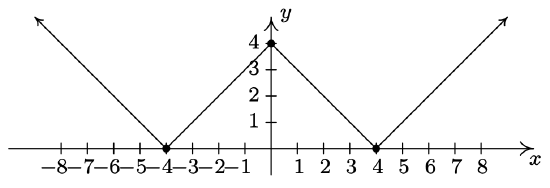
- With help from your classmates, prove the second, third and fifth parts of Theorem 2.2.1.
- Prove The Triangle Inequality: For all real numbers \(\ a\) and \(\ b\), \(\ |a+b| \leq|a|+|b|\).
Answers
- \(x = -6\) or \(x=6\)
- \(x = -3\) or \(x= \frac{11}{3}\)
- \(x = -3\) or \(x= 11\)
- \(x = -1\) or \(x= 1\)
- \(x=-\frac{1}{2}\) or \(x= \frac{1}{10}\)
- no solution
- \(x=-3\) or \(x= 3\)
- \(x = -\frac{13}{8}\) or \(x= \frac{53}{8}\)
- \(x=-\frac{3}{2}\)
- \(x=0\) or \(x= 2\)
- \(x=1\)
- no solution
- \(x=-1\), \(x= 0\) or \(x= 1\)
- \(x=-3\) or \(x=3\)
- \(x=-2\) or \(x=2\)
- \(x = -1\) or \(x = 9\)
- \(x = -\frac{1}{7}\) or \(x = 1\)
- \(x = 0\) or \(x = 2\)
- \(x=1\)
- \(x = -\frac{3}{10}\)
- \(x = \frac{1}{5}\) or \(x = 5\)
- \(f(x) = |x + 4|\)
\(f(-4) = 0\)
\(x\)-intercept \((-4, 0)\)
\(y\)-intercept \((0, 4)\)
Domain \((-\infty, \infty)\)
Range \([0, \infty)\)
Decreasing on \((-\infty, -4]\)
Increasing on \([-4, \infty)\)
Relative and absolute min. at \((-4,0)\)
No relative or absolute maximum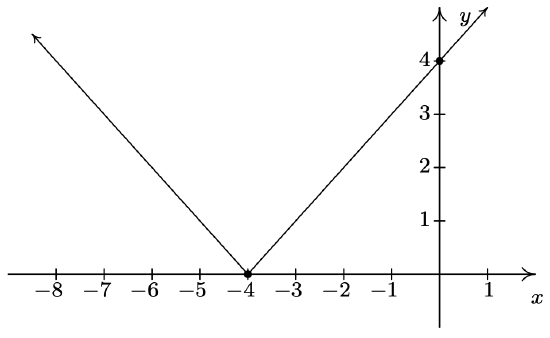
-
\(\ f(x)=|x|+4\)
No zeros
No \(x\)-intercepts
\(y\)-intercept \((0, 4)\)
Domain \((-\infty, \infty)\)
Range \([4, \infty)\)
Decreasing on \((-\infty, 0]\)
Increasing on \([0, \infty)\)
Relative and absolute minimum at \((0, 4)\)
No relative or absolute maximum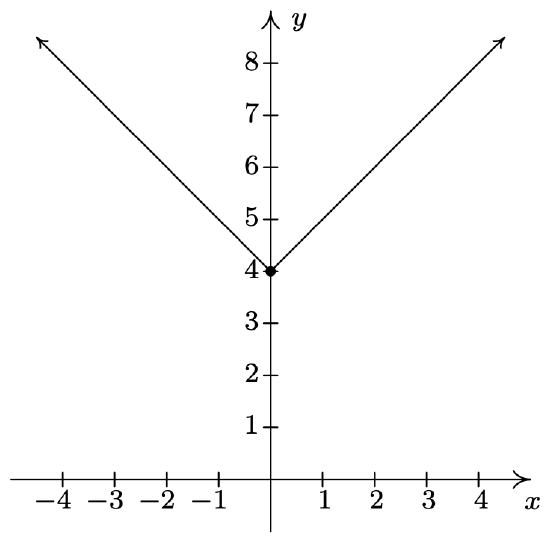
-
\(\ f(x)=|4 x|\)
\(f(0) = 0\)
\(x\)-intercept \((0, 0)\)
\(y\)-intercept \((0, 0)\)
Domain \((-\infty, \infty)\)
Range \([0, \infty)\)
Decreasing on \((-\infty, 0]\)
Increasing on \([0, \infty)\)
Relative and absolute minimum at \((0, 0)\)
No relative or absolute maximum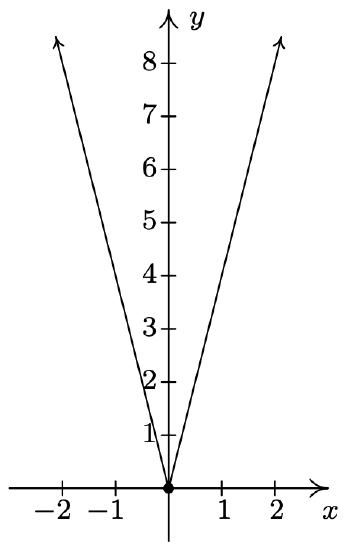
-
\(f(x) = -3|x|\)
\(f(0) = 0\)
\(x\)-intercept \((0, 0)\)
\(y\)-intercept \((0, 0)\)
Domain \((-\infty, \infty)\)
Range \((-\infty, 0]\)
Increasing on \((-\infty, 0]\)
Decreasing on \([0, \infty)\)
Relative and absolute maximum at \((0, 0)\)
No relative or absolute minimum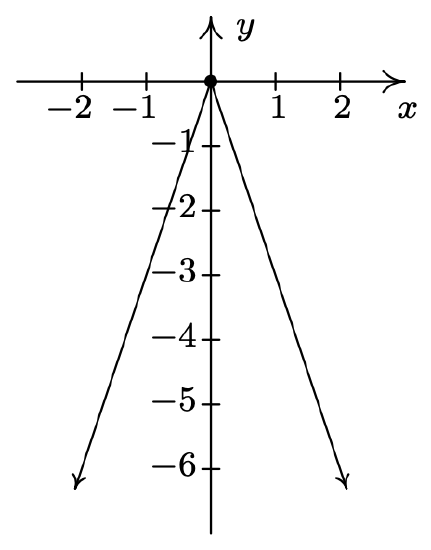
-
\(f(x) = 3|x + 4| - 4\)
\(f\left(-\frac{16}{3}\right) = 0\), \(f\left(-\frac{8}{3}\right) = 0\)
\(x\)-intercepts \(\left(-\frac{16}{3}, 0\right)\), \(\left(-\frac{8}{3}, 0\right)\)
\(y\)-intercept \((0, 8)\)
Domain \((-\infty, \infty)\)
Range \([-4, \infty)\)
Decreasing on \((-\infty, -4]\)
Increasing on \([-4, \infty)\)
Relative and absolute min. at \((-4,-4)\)
No relative or absolute maximum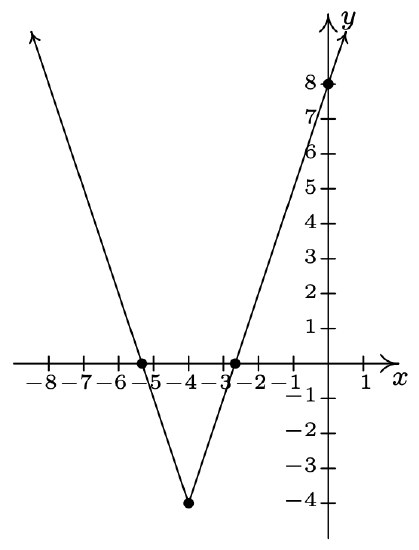
-
\(f(x) = \frac{1}{3}|2x - 1|\)
\(f\left(\frac{1}{2}\right) = 0\)
\(x\)-intercepts \(\left(\frac{1}{2}, 0\right)\)
\(y\)-intercept \(\left(0, \frac{1}{3}\right)\)
Domain \((-\infty, \infty)\)
Range \([0, \infty)\)
Decreasing on \(\left(-\infty, \frac{1}{2}\right]\)
Increasing on \(\left[\frac{1}{2}, \infty\right)\)
Relative and absolute min. at \(\left(\frac{1}{2},0\right)\)
No relative or absolute maximum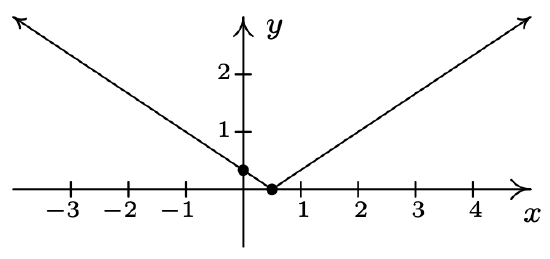
-
z\(f(x) = \dfrac{|x + 4|}{x + 4}\)
No zeros
No \(x\)-intercept
\(y\)-intercept \((0, 1)\)
Domain \((-\infty, -4) \cup (-4, \infty)\)
Range \(\{-1, 1\}\)
Constant on \((-\infty, -4)\)
Constant on \((-4, \infty)\)
Absolute minimum at every point \((x, -1)\) where \(x < -4\)
Absolute maximum at every point \((x, 1)\) where \(x > -4\)
Relative maximum AND minimum at every point on the graph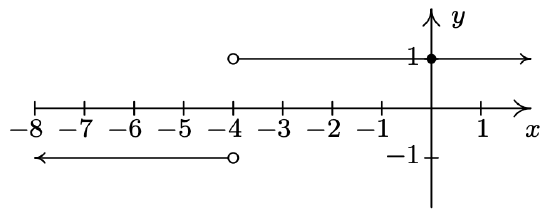
-
\(f(x) = \dfrac{|2 - x|}{2 - x}\)
No zeros
No \(x\)-intercept
\(y\)-intercept \((0, 1)\)
Domain \((-\infty, 2) \cup (2, \infty)\)
Range \(\{-1, 1\}\)
Constant on \((-\infty, 2)\)
Constant on \((2, \infty)\)
Absolute minimum at every point \((x, -1)\) where \(x > 2\)
Absolute maximum at every point \((x, 1)\) where \(x < 2\)
Relative maximum AND minimum at every point on the graph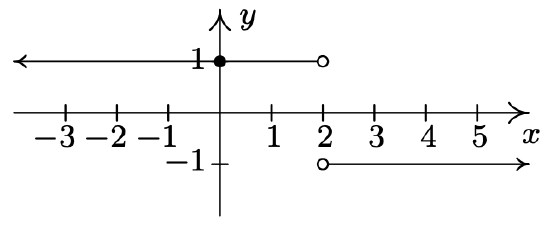
-
Re-write \(f(x) = x+|x| - 3\) as
\({\displaystyle f(x) = \left\{ \begin{array}{rcl} -3 & \mbox{ if } & x < 0\\ 2x -3 & \mbox{ if } & x \geq 0 \\ \end{array} \right. }\)
\(f\left(\frac{3}{2}\right) = 0\)
\(x\)-intercept \(\left(\frac{3}{2}, 0\right)\)
\(y\)-intercept \((0,-3)\)
Domain \((-\infty, \infty)\)
Range \([-3, \infty)\)
Increasing on \([0,\infty)\)
Constant on \((-\infty, 0]\)
Absolute minimum at every point \((x,-3)\) where \(x \leq 0\)
No absolute maximum
Relative minimum at every point \((x, -3)\) where \(x \leq 0\)
Relative maximum at every point \((x, -3)\) where \(x < 0\)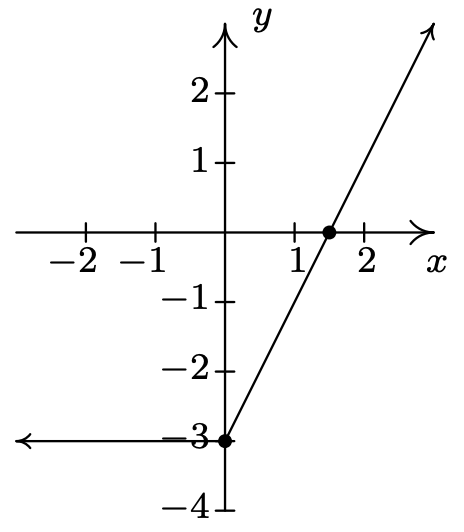
-
Re-write \(f(x) = |x+2| - x\) as
\({\displaystyle f(x) = \left\{ \begin{array}{rcl} -2x-2 & \mbox{ if } & x < -2\\ 2 & \mbox{ if } & x \geq -2 \\ \end{array} \right. }\)
No zeros
No \(x\)-intercepts
\(y\)-intercept \((0,2)\)
Domain \((-\infty, \infty)\)
Range \([2, \infty)\)
Decreasing on \((-\infty, -2]\)
Constant on \([-2,\infty)\)
Absolute minimum at every point \((x,2)\) where \(x \geq -2\)
No absolute maximum
Relative minimum at every point \((x, 2)\) where \(x \geq -2\)
Relative maximum at every point \((x, 2)\) where \(x > -2\)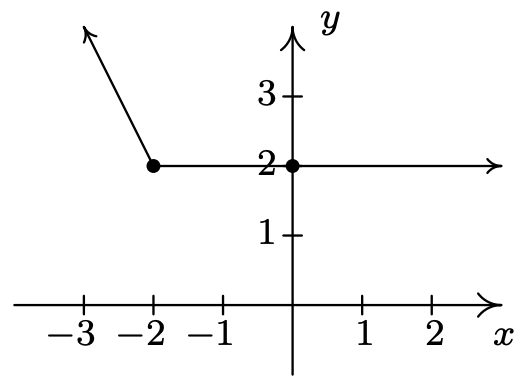
-
Re-write \(f(x) = |x+2|-|x|\) as
\({\displaystyle f(x) = \left\{ \begin{array}{rcl} -2 & \mbox{ if } & x < -2\\ 2x+2 & \mbox{ if } & -2 \leq x < 0 \\ 2 & \mbox{ if } & x \geq 0 \\ \end{array} \right. }\)
\(f\left(-1\right) = 0\)
\(x\)-intercept \(\left(-1, 0\right)\)
\(y\)-intercept \((0,2)\)
Domain \((-\infty, \infty)\)
Range \([-2,2]\)
Increasing on \([-2,0]\)
Constant on \((-\infty, -2]\)
Constant on \([0,\infty)\)
Absolute minimum at every point \((x,-2)\) where \(x \leq -2\)
Absolute maximum at every point \((x,2)\) where \(x \geq 0\)
Relative minimum at every point \((x, -2)\) where \(x \leq -2\) and at every point \((x,2)\) where \(x>0\)
Relative maximum at every point \((x, -2)\) where \(x < -2\) and at every point \((x,2)\) where \(x \geq 0\)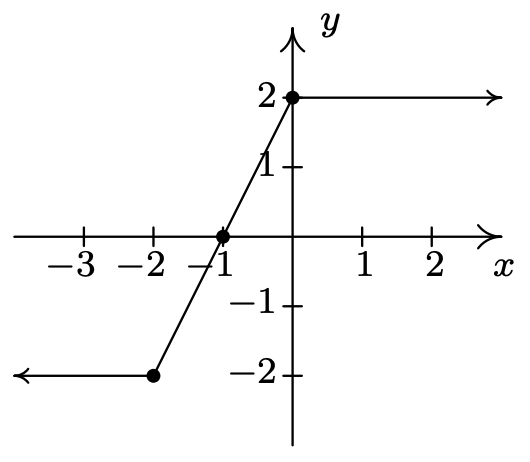
-
Re-write \(f(x) = |x + 4| + |x - 2|\) as
\({\displaystyle f(x) = \left\{ \begin{array}{rcl} -2x - 2 & \mbox{ if } & x < -4\\ 6 & \mbox{ if } & -4 \leq x < 2\\ 2x + 2 & \mbox{ if } & x \geq 2 \end{array} \right. }\)
No zeros
No \(x\)-intercept
\(y\)-intercept \((0, 6)\)
Domain \((-\infty, \infty)\)
Range \([6, \infty)\)
Decreasing on \((-\infty, -4]\)
Constant on \([-4, 2]\)
Increasing on \([2, \infty)\)
Absolute minimum at every point \((x, 6)\) where \(-4 \leq x \leq 2\)
No absolute maximum
Relative minimum at every point \((x, 6)\) where \(-4 \leq x \leq 2\)
Relative maximum at every point \((x, 6)\) where \(-4 < x < 2\)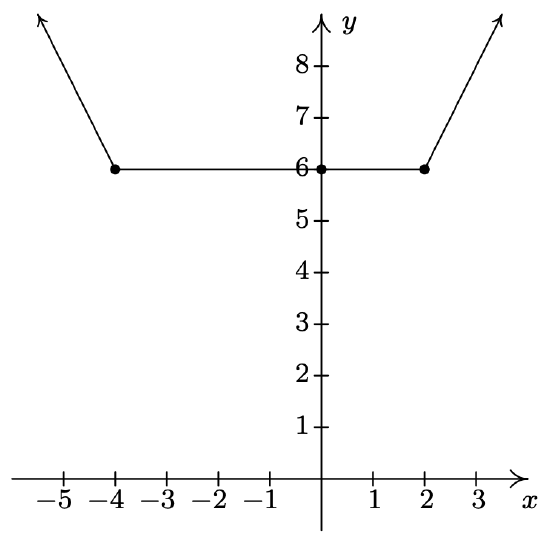
- \(f(x) = ||x| - 4|\)

